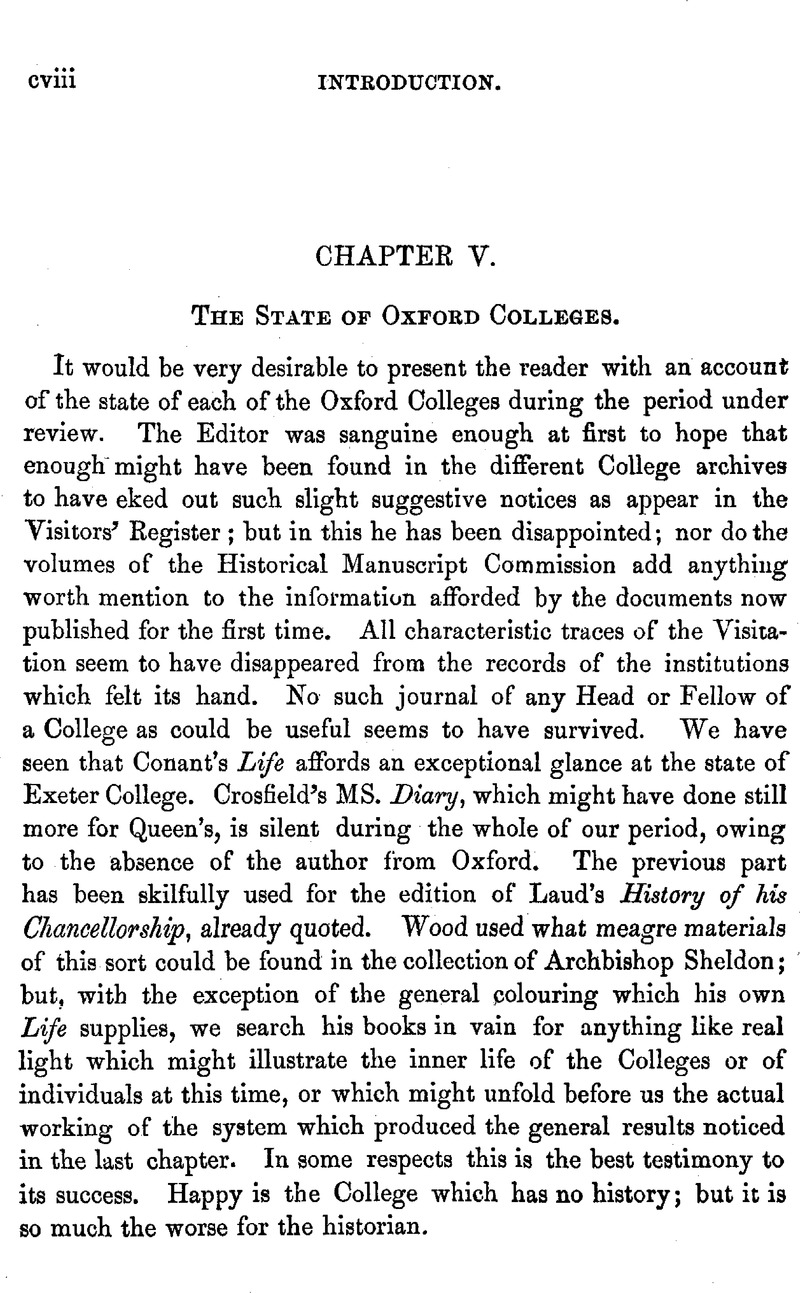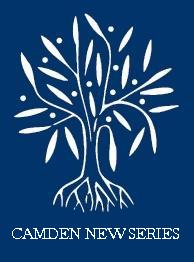No CrossRef data available.
Article contents
Chapter V. The State of Oxford Colleges
Published online by Cambridge University Press: 04 January 2010
Abstract

- Type
- Introduction
- Information
- Camden New Series , Volume 29: The Register of the Visitors of The University of Oxford from A.D. 1647 to A.D. 1658 , December 1881 , pp. cviii - cxxxiii
- Copyright
- Copyright © Royal Historical Society 1881
References
page cix note a This was evinced not only by the acts of certain persons, but by the election of men as “Postmasters” who had refused to submit to the Visitation.
page cx note a Exeter is one of ten Colleges, the Heads of which petitioned Cromwell (Feb. 28, 1654) for payment of “arrears of augmentations to their places and constant payment in future,” on the ground that “our places are so poor as not to afford a competent maintenance, and on account of our augmentations we are debarred the enjoyment of such places of emolument as were formerly allowed.” The Petition was granted, and the arrears paid. The names of the Heads of these Colleges stand in the following order, which appears to be that of seniority: Lincoln, Queen's, University, Brasenose, Wadham, Trinity, St. John's, Exeter, Jesus, and Balliol. Pembroke is mentioned at an earlier date (July 27, 1653) in this connection—“the augmentation of Pembroke College”—but not in special reference to the Headship. Oriel is the only College which, being reported by the Visitors “to stand in neede of augmentation” (July 26, 1649), is not named in any document registered in the latest volumes of the Calendar of State Papers, 1653, 1654, from which the above extracts are taken. The “augmentations” had been granted, in consequence of the Report of the Visitors (Register, pp. 246, 251, 252), out of the public Treasury, probably out of the fund produced by the Firstfruits and Tenths, which had previously belonged to the Crown, but were now set aside for purposes of this kind. It was these which, at a later date, formed “Queen Anne's Bounty.” (The above Petition of the Heads should have been mentioned in the note to pp. 251–2; but it had not attracted the attention of the Editor in time to insert it in its proper place.)
page cxi note a Tozer had been a decided anti-Arminian, probably of Prideaux' school, one of the Assembly of Divines (though he did not attend), a good preacher, and the author of popular devotional Works. He died at Rotterdam in 1650. Archbishop Ussher's influence on the College should not be forgotten. He resided for some time during the war in a part of the buildings now destroyed, but the woodwork from which was transferred to “Prideaux Buildings,” erected of late years between the College and Mr. Parker's house, facing the Turl. (Boase, 's Reg. Exon. p. 197.)Google Scholar
page cxiii note a In the Journal of the House of Commons, June 21, 1650, will be found an Order to the Committee for the Universities to examine what officers, &c., neglect or refuse to take the Engagement, “with power to displace such officers, &c.,” and to replace them by others. It has been already noticed how this order affected Reynolds, Mills, Cheynell, and Pocock; and the Register shows how it led to the quarrel between the Committee and the Visitors; but its immediate effects were chiefly confined to Christchurch.
page cxiii note b Life, as abore, p. 146.
page cxv note a Magdalen ought to be added to the list of Colleges (p. 365) receiving freedom to elect at an early date. “Magdalen-tyde” (p. 277) means the period from July 22 (Fest. S. M. Magd.) to the octave.
page cxv note b Letters of Humphrey Prideaux, p. (Camden Soc.)
page cxvi note a The following notice of Oxford studies may be extracted from the Life of Sir Leoline Jenkins, by Wynne (1724). When the future statesman was residing in Oxford with his pupils in 1652, he writes thus “to the vertuous and noble Lady A” about her son: “I hope in time to bring him acquainted with Logick and Philosophy (the chief learning of this place), which, if understood, will be an excellent help to manage his reason and discourse, so as to speak concludent to any purpose.” It may be worth noting that the character of Sir L. Jenkins stood so high that it was commonly reported he was to take Orders, and succeed Sheldon as Archbishop of Canterbury. (Letters of Humphrey Prideaux, p. 54.) For an acquaintance with his Life of Mansell the writer is indebted to the Rev. W. Dyke, of Jesus, who printed the book in 1854.
page cxx note a See W. of All Souls, p. 241.Google Scholar
page cxx note b See Note, p. 244.
page cxxii note a See Note, p. 80.
page cxxii note b See Durham's Life of Harris (1660), Warton's Life of Bathurst, Chalmer's Biog. Dict., Wood's Ath. Ox. and Annals.
page cxxiii note a Langbaine and Barlow began life, and went on afterwards, together. They were admitted to Queen's in 1625 as servientes ad mensam, and in 1630 in pauperes pueros; and they became Scholars together in 1633. On the death of Langbaine in 1667, Barlow succeeded him as Proyost. When preferred to the bishopric of Lincoln, he takes leave of the College (in 1677) in an eloquent letter, referring to the “52 years compleat” which had passed “since I had the happiness to be admitted into our House, and ever since have had encouragement and subsistence from my dear mother the College.”—Queen's College Register, to which access was afforded by the kindness of the Provost, Dr. Magrath.
page cxxiii note b Ath. Ox. vol. iv. p. 334.Google Scholar
page cxxiii note c See Barlow's Remains, by Sir Peter Pett.
page cxxiv note a See Note, p. 139.
page cxxiv note b For these facts and some others connected with New College the writer has to thank the Warden, Dr. Sewell. The state of the old Register in that College affords a pleasing contrast to the state of the Register in some others, hut even here the identification of several names has been found impossible.
page cxxvi note a Laud's Works as above, vol. v. p. 244.Google Scholar
page cxxvi note b It should be mentioned that one of these, Queen's, had made an exceptionally large contribution to Charles the First, in reply to his letters of request in 1642.
page cxxvi note c The present Convocation House was built under Laud's auspices, and first used on Oct. 10, 1638. Thus he first, and Sheldon afterwards (by building the Theatre), put a stop to the habitual desecration of St. Mary's Church.
page cxxxi note a Still less the number attained under Conant's Vice-chancellorship in 1658, when there were 460 matriculations. In the early part of the present century the average number of matriculations was considerably below 300. In 1835 the number had reached 369; in 1849, 440; in 1858 it fell to 399. In 1869 it had reached 583, and in 1877, 769. In 1879 it was 798. The numbers at each College and Hall in 1849 have been selected for the Tabular Statement as showing their normal condition in modern times before the changes effected by the Royal Commission of 17 and 18 Vict, came into operation, and before any general enlargement of Colleges had taken place.
page cxxxi note b A few notes of this visit may be interesting. M. Sorbières was a distinguished man of science, and brought the best introductions from Paris. He visited all the professors, but found them, like the English generally, taciturn. Nor were even Drs. Wallis and Willis, whom he reckoned as the most celebrated, any exception. He obtained more information from the courteous Mr. Lockey, Bodley's Librarian, who lived in Christchurch. This, he was told, “is one of the greatest and richest Colleges, for it has an income of 70,000 livres. There are seventeen or eighteen Colleges which are nearly all on a similar scale. The quadrangle of Christchurch is scarcely less than that enclosed within the barriers of the Place Royale. There is one College where I saw a great bronze nose over the gate, as if it were a Polchinello's mask. They told me it was also called the College of the Nose, and that the nose over the gate was a likeness of that of John Duns Scotus, who had taught there. The last I visited was St. John's, which is the most regularly built, though not the richest.” He then describes the quadrangle of St. John's, which, he says, is as large as that of the Louvre, the library, the gallery, and the picture of Charles the First upon ivory, made of lines of minute writing, comprising the whole of the Psalms in Latin. He then visited the Bodleian, which he greatly admired, and where he saw the sword presented by the Pope to Henry the Eighth. He concludes that “Oxford would not be what it is except for the Colleges; for there are no more inhabitants than are required to supply the wants of three or four thousand students, and to cultivate a very pleasant plain in which the city is situated, upon a little river, extremely full of fish, which falls near this into the Thames.” (Relation d'un voyage en Angleterre, par M. Sorbières, Cologne, 1666,) The attention of the writer was directed to this curious book by T. H. Ward, M.A., Tutor of Brasenose.
page cxxxii note a The phrase used in the “Abolition of Tests Act.”


